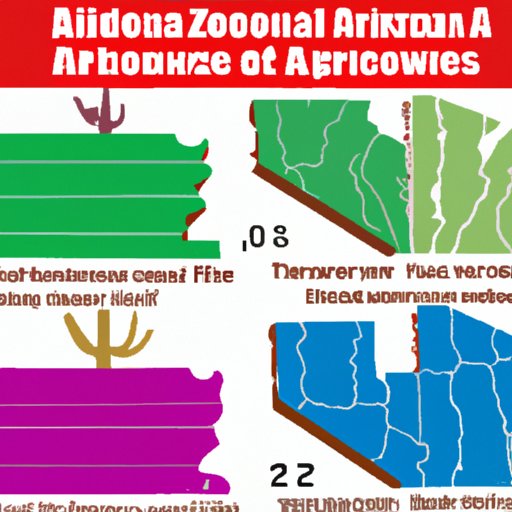I. Introduction
Have you ever wondered how many counties are in Arizona? With the state’s vast size, it can be challenging to know the exact number. However, Arizona is home to 15 counties, each with its unique history, landmarks, and places of interest.
The purpose of this article is to provide a comprehensive guide to help you understand Arizona’s diverse regions. From exploring the state’s history to offering tips on the best places to visit, this article will give you an in-depth understanding of each county.
II. Exploring Arizona: A County-by-County Breakdown
Arizona has 15 counties, each with its unique features. To help you get a better understanding of each county, let’s explore each one.
Apache County – Located in the northeastern part of Arizona, Apache County is home to many natural landmarks such as the Petrified Forest National Park, Canyon de Chelly National Monument, and the Apache-Sitgreaves National Forest. The county’s largest city is St. Johns.
Cochise County – Located in the southeastern part of the state, Cochise County is home to iconic landmarks such as Kartchner Caverns and Tombstone. The county seat is Bisbee, a charming mining town with a rich history.
Coconino County – Known for its Grand Canyon National Park, Coconino County is a popular tourist destination. The county’s largest city is Flagstaff, which hosts Northern Arizona University, the Lowell Observatory, and the Museum of Northern Arizona.
Gila County – Located in central Arizona, Gila County is home to Tonto National Forest, Roosevelt Lake, and the charming town of Payson.
Graham County – Located in the southeastern part of the state, Graham County is home to Mount Graham, a popular spot for stargazing. The county’s largest city is Safford.
Greenlee County – A small county located in southeastern Arizona, Greenlee County is surrounded by mountains and is known for its mining industry.
La Paz County – Located in western Arizona, La Paz County is home to the town of Parker, where visitors can enjoy water activities on the Colorado River.
Maricopa County – The most populous county in Arizona, Maricopa County is home to Phoenix, the state capital. The county is known for its sports, cultural attractions, dining, and nightlife.
Mohave County – Located in northwestern Arizona, Mohave County is home to the Grand Canyon Skywalk and Lake Havasu City, known for its famous London Bridge.
Navajo County – Home to many natural landmarks and historic sites, including the Painted Desert and the Navajo Nation, Navajo County is located in the northeastern part of the state.
Pima County – Located in southern Arizona, Pima County is home to Tucson, the state’s second-largest city, and the Saguaro National Park.
Pinal County – Located in central Arizona, Pinal County is home to the Casa Grande Ruins National Monument and many other historic sites. The county seat is Florence.
Santa Cruz County – Located in southeastern Arizona, Santa Cruz County is home to the historic town of Tubac and the Tumacácori National Historical Park.
Yavapai County – Known for its forested mountains, Yavapai County is home to Jerome, a historic mining town, and Sedona, a popular tourist destination.
Yuma County – Located in southwestern Arizona, Yuma County is known for its agriculture and military presence. The county seat is Yuma, a charming town with a rich history.
III. Arizona County Facts and Figures
Now that we have explored each county let’s take a look at some key data and statistics for each county.
According to the Arizona Office of Economic Opportunity, as of April 2021, the most populous county in Arizona is Maricopa County, followed by Pima County, and Pinal County.
In terms of land area, Coconino County is the largest with 18,661 square miles, followed by Navajo County with 9,959 square miles. Greenlee County is the smallest with just 1,848 square miles.
Arizona is home to five regions: the Grand Canyon Region, North Central Region, South Central Region, Northeast Region, and the Southern Region. Each region is home to unique geographical features and landmarks.
IV. Visiting Arizona’s Counties: A Travel Guide
If you’re planning a visit to Arizona, each county offers something unique that you won’t want to miss.
For nature lovers, Coconino County is a must-visit destination with its breathtaking Grand Canyon National Park. Pima County, home to the Saguaro National Park, is also a great place to visit for outdoor enthusiasts.
If you’re interested in history, Cochise County and Tombstone are both full of fascinating stories and landmarks. Additionally, Santa Cruz County offers an authentic experience of the Wild West with its historic town of Tubac.
For those looking for a relaxed style of travel, La Paz County, with its water activities and Colorado River views, is a great spot to visit.
V. Arizona County Rankings: A Comparison Guide
If you’re curious about how each county ranks compared to others in Arizona, we’ve compiled a list of rankings on various factors below:
– Economy: Maricopa County
– Crime: Graham County
– Education: Greenlee County
– Health: Yuma County
VI. Arizona County Histories: Exploring Arizona’s Past
Each Arizona county is home to a rich history. From the mining industry in Greenlee County to the wild west in Cochise County, there’s plenty to learn about each county’s past.
Apache County is home to the Navajo Nation, the largest Native American reservation in the country. The tribe has a rich history and culture that visitors can experience through their museums, dances, and crafts.
Gila County was once a major mining area, and visitors can explore its mining history at the Old Dominion Mine Park and Museum.
VII. Conclusion
Arizona’s 15 counties offer a diverse range of activities, landmarks and historical sites for visitors to explore. In this article, we have explored the unique features of each county, important data and statistics, travel tips, rankings, and history. By using this guide, you can discover all Arizona has to offer and plan your perfect trip.
